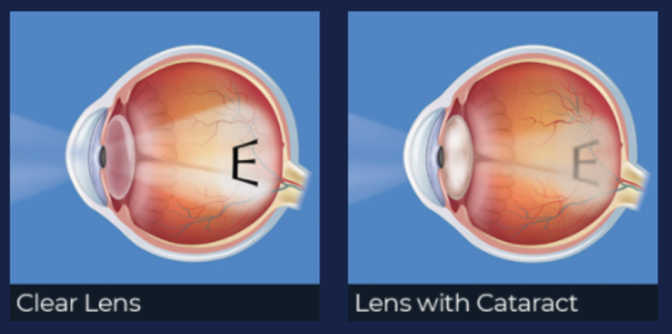Cataract Surgery in Birmingham & Troy, MI

See an Oakland Ophthalmic Cataract Specialist
After a lifetime of clear vision, one day it can seem as if your vision is failing and even a new eyeglass prescription can’t help. You might have cataracts, but don’t panic! There’s still hope. You can see life clearly again without cataracts with the help of our expert cataract eye surgeons at Oakland Ophthalmic Surgery in Birmingham & Troy, MI. We offer cataract surgery treatment using state-of-the-art technology and techniques to reclaim your vision.
Escape the fear and frustration of cataracts and book an appointment today!
What Are Cataracts?
A cataract is a clouding of the lens inside your eye. Think of the lens like a window: when it becomes cloudy, it’s more difficult to see through the window clearly. Cataracts affect the eye in much the same way. Cataracts are a natural part of the aging process. Everyone begins to develop cataracts around age 50 and symptoms worsen in a large number of people. More than half of all Americans will have cataract surgery by age 80. When a cataract forms, clouding prevents some of the light from passing through the lens, resulting in poor vision.
What Causes Cataracts?
Cataracts are most often the result of the natural aging process, as proteins in the lens of your eye break down and clump together. This usually starts around age 40, and may not be noticeable until around age 60, but can vary from person to person. It is widely believed that exposure to ultraviolet light also contributes to the growth of cataracts. Although less common, cataracts can be congenital, the result of another disease in the body, or develop after an eye injury.

For most people, cataracts progress slowly. Eventually, cataracts can impair your vision and impact your daily activities, requiring surgical treatment.
Fortunately, the cloudy natural lens in your eye can be safely removed and replaced with a man-made lens with specific focusing power for your individual needs.
To find out if you qualify for cataract surgery, call the experienced Birmingham & Troy eye surgeons of Oakland Ophthalmic Surgery, and schedule a consultation.
Symptoms of Cataracts
If you’re experiencing any of the following symptoms, you may have cataracts, and could potentially benefit from life-changing cataract surgery:

Cloudy or blurred vision

Double vision

Faded colors

Trouble seeing at night

Light and glare sensitivity

Seeing halos around lights
If you have any of these symptoms or have been told you have cataracts, schedule an appointment online, or call (248) 644-8060 to schedule an evaluation with the cataract surgeons of Oakland Ophthalmic Surgery today.
Cataracts Removal & Treatment
When cataracts begin to impair your quality of life, it is important to have an evaluation with your eye doctor. You can take advantage of a once-in-a-lifetime opportunity to achieve better vision—potentially even better than you had before cataracts developed.
Cataract surgery is one of the most commonly performed procedures in the U.S. It’s a brief painless outpatient procedure during which the eye’s natural lens is removed and replaced with an intraocular lens (or IOL for short). Cataract removal and lens implantation are safe and effective. At Oakland Ophthalmic Surgery, we are pleased to offer a variety of Advanced Technology Intraocular Lens (ATIOL) options to our patients.

Frequently Asked Questions About Cataracts
There is no certain way to prevent the development of cataracts or to slow their progression. However, taking the following steps to safeguard the health of your eyes may help:
Undergo regular eye examinations
Eat a healthy diet
Don’t smoke
Wear sunglasses with UV protection
Address other health problems
Cataracts are a natural part of the eye’s aging process and impact everyone. However, there are some risk factors that may put certain people at higher risk for developing cataracts at an earlier age. These include:
Diabetes
High blood pressure
Nearsightedness
Obesity
Smoking
Excessive sunlight exposure
Previous eye surgery
Eye injury and/or inflammation
Use of corticosteroid medications
Excessive alcohol consumption
Yes. If you’ve had LASIK surgery in the past you can still have cataract surgery.
When cataracts progress to the point where clouding of the lens causes vision loss or impairment that impedes daily activities, cataract surgery is deemed medically necessary and is typically covered by medical insurance.
Basic Intraocular Lenses (IOLs) will eliminate the cloudiness caused by cataracts and are covered by insurance, but you may incur out-of-pocket expenses if you and your surgeon choose an advanced technology implant (ATIOL) or laser technology.
Be sure to ask your surgical counselor about flexible payment options.
No, each eye is operated on separately, usually 1-4 weeks apart.
Eye surgery is like surgery on any other body part—there will be a period of recovery. Fortunately for cataract surgery, this time is minimal. Your vision will be blurry right after surgery, but most patients are able to go back to normal daily activities in as little as 24-48 hours.
While you are awake during cataract surgery, your doctor will use anesthetic eye drops to numb your eyes. You will also be given a sedative to help you relax during the procedure.
The actual procedure is not painful. Most patients feel mild to moderate irritation for the first few days after surgery, similar to having an eyelash in the eye. Artificial tears may be used as often as necessary to reduce this irritation.
ATIOLs (Multifocal implants for astigmatism and presbyopia) may help you avoid having to wear glasses or contacts altogether. Using a basic single-focus implant, you will still require at least a reading prescription. Be sure to ask your doctor about your advanced technology implant (ATIOL) options.
Once removed, cataracts cannot return. In some cases, however, cloudiness (posterior capsule fibrosis) may occur in the lens capsule months or years after surgery. This eye condition is also treatable with a safe and painless laser procedure.
The Light Adjustable Lens is made of a special photosensitive material that changes the shape and power of your implanted lens in response to ultraviolet (UV) light. Light treatments are delivered in your doctor’s office with the Light Delivery Device (LDD).
The U.S. Food and Drug Administration has approved the Light Adjustable Lens and Light Delivery Device for patients with pre-existing astigmatism of 0.75 diopters or more who are undergoing cataract surgery. Other commercially available IOLs may be available for the treatment of your cataracts and your doctor will help you determine which lens is right for you.
There are 2 major differences following your Light Adjustable Lens surgery as compared to a non-adjustable intraocular lens (IOL):
Required wear of ultraviolet (UV) protective glasses
Completion of light treatments
Exposure to indoor and outdoor sources of UV light can cause uncontrolled changes to the Light Adjustable Lens. To prevent this, you will be provided with UV protective glasses to wear immediately following surgery during all waking hours (from time of lens implantation until after the last light treatment is completed).
Your protective glasses may be removed when sleeping, and may be temporarily removed when showering, washing your face, or applying eye drops as long as you are not exposed to direct sunlight. Twenty-four hours after your final light treatment, no further changes can be made to the implanted Light Adjustable Lens, and you can remove the UV protective glasses and enjoy your custom vision!

Visit Our Cataract Specialists in Birmingham and Troy
Think you might need cataract surgery? Schedule an appointment with our Birmingham and Troy, MI cataract surgeons at Oakland Ophthalmic Surgery to discover if you qualify for cataract surgery.
“More than half of all Americans will have cataract surgery by age 80.”
Reference: 1. Facts about cataract. National Eye Institute Website. https://nei.nih.gov/health/cataract/cataract_facts. Accessed March 08, 2022.

 248-644-8060
248-644-8060 248-644-5081
248-644-5081